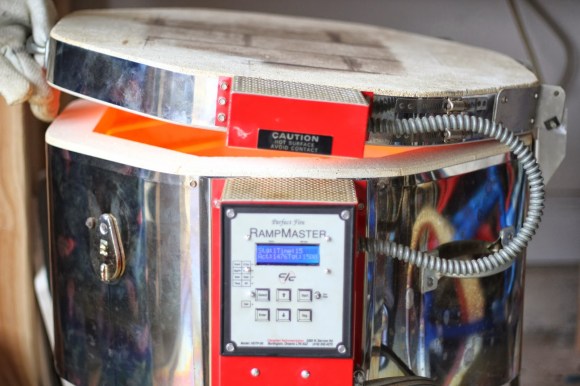 [Richard]’s wife scored an Evenheat glass-fusing kiln, but the 20-year-old temperature controller was broken. He could have simply ordered a replacement controller, but that kind of problem solving doesn’t get you on Hack a Day. His wife wanted more control over the kiln and he convinced her that building their own was the way to go. Thus, the Meltinator 9000 was born.
[Richard]’s wife scored an Evenheat glass-fusing kiln, but the 20-year-old temperature controller was broken. He could have simply ordered a replacement controller, but that kind of problem solving doesn’t get you on Hack a Day. His wife wanted more control over the kiln and he convinced her that building their own was the way to go. Thus, the Meltinator 9000 was born.
[Richard]’s design uses an Arduino Uno and an Adafruit display shield, protoshield, and thermocouple reader board. He built a simple relay driver with a resistor, BJT, and a diode and connected it to pin 13 and its built-in indicator. To [Richard]’s delight, all of this fit in the original enclosure.
[Richard]’s software provides 25 fusing schedules with ten steps apiece. Each step has a target temperature, rate of temperature change, and a hold time which can be increased on the fly. He ran a test program that heated the kiln to 1500°F at a rate of 2550°F/hour. He then cooled it to 500°F at a rate of 1000°F/hour, which took longer than he thought. The good news is that the kiln is well-insulated! [Richard] has the software available on his GitHub.
Don’t have a glass kiln? Prefer to control beer-related temperatures? You could always hack your stove in the name of homebrewing.















Copper melts at 1083C [1981F]. Standard glass melts at 1500C [2700F],with high grad melting at 2300C [4200F]. Forget etching – you can now MELT copper.
I suspect the actual components wouldn’t be happy, however. [Pure, chip] silicon melts at 1414C so you’re best off holding at 1100C – components should sink into the molten copper with no need for solder.
Please report on results!
The fusing temperature of glass and the liquidus temperature are not the same thing…. With the kind of work these kilns are made for, they rarely see anything near hot enough to actually totally melt glass into a liquid through and through.
The most common kind of glass, soda lime glass, starts becoming workable usually at a temperature more like ~550C.
The glass melting temperatures you quotes are higher than the melting temperature of the nichrome resistance wire commonly used as heating elements in these kilns.
Are those heating/cooling rates normal for a commercial kiln? If they aren’t how do these rates affect the longevity of the insulation/elements?
They use Kanthal instead of Nichrome. Theses Kilns all top out at about 1300C.
Pots bisque ( hard but stil porous to accept glazes) at 900C. A ceramic glaze is fired at from 800-1300 C depending on properties of clay body and glaze.
You need 1400C for Porcelain – kilns don’t last long up there.
Glass needs one special feature. Annealing. Although it pours and can be cast at about 850C for (say) Gaffer Lead crystal glass – It requires a very slow annealing ramp to ensure the glass cools evenly through the strain-point and does not crack.
This can be as slow as <1 degreeC per hour. So it can take weeks to safely cool thick pieces of glass. This is where these controllers are good.
Although many fail to take into account a timer that runs that long (you need more than 16bits). Or they break it into several ramps.
I'm definattely looking more closely at this project. The OSPID people have a good solutoin also – boxed and ready to go with K thermocouple input boards.
http://www.ospid.com/blog/
If it needs to run the elements at part power for a significant time, phase angle control makes a lot of sense.
It is rather disappointing there isnt a real BOM or any mention of what thermocouple was used. Just a generic reference to a thermocouple reader board.
I believe it is this one: http://www.adafruit.com/products/269
Sorry for being vague! I’ve update the blog post to include links to the adafruit pages where the parts can be purchased. The thermocouple is a K-type using a MAX31855 thermocouple amplifier/reader. -Richard
thank you richard.
I always support a good inator.
What is it’s max temperature? It’s over 9000!!!!